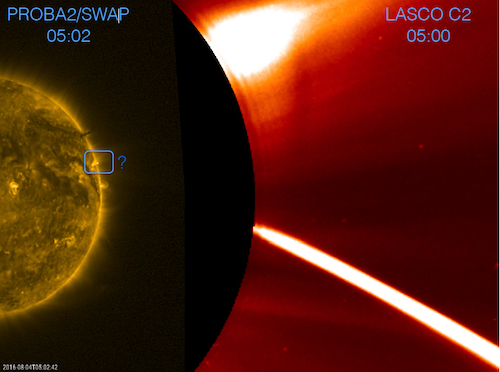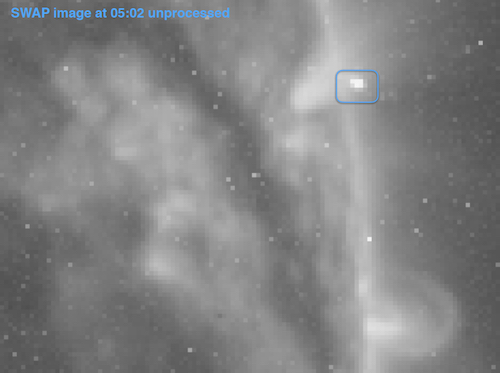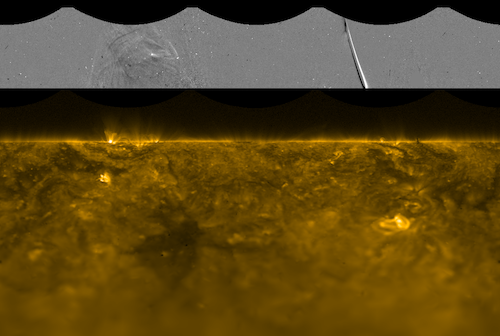On August 4, a very bright Kreutz Comet made a crashing collapse on the Sun.
It came into the view of the coronograph LASCO C2 onboard SOHO at the start of the UT day. It flew through its field of view, the comet itself passed the inner LASCO boundaries around 4UT, while the dust tail disappeared completely by 11UT. The ESA satellite PROBA2 was like always also keeping an eye on the EUV sun. PROBA2 didn’t see any obvious comets flying though the field of view. But at 05:02:42, 5 pixels at the west limb lighted up.

This is a PROBA2/SWAP image combined with a LASCO/C2 images. The comet is visible at the right, the mysterious pixel brightening in the blue rectangular.
Because we couldn't get enough from these mysterious pixels, we made a close up:

The brightening is visible in only 1 image. PROBA2 makes pictures roughly every 2 minutes. The timing could coincide with the comet crashing into the Sun. Exciting! The pixel-comet lightening could not be confirmed yet with other observations. It was really a pity that SDO was not observing at that moment :-(
We made also other cool stuff: PROBA2 EUV and LASCO C2 difference images of in LogPolar coordinates.

For LogPolar coordinates, we cut along a radius, open and bend the circle such that we get a straight solar surface. The picture is the most stretched near the centre of the solar disc.
You can make your own movies with the app JHelioviewer. Get it on http://www.jhelioviewer.org Don't forget to try it!
It has two tails and moves through space. What is it?
Before answering this question, this. A comet has 2 tails: a dust and an ion tail. The ion tail exist out of gas to becomes ionised because of the solar radiation and follows the laws of the solar wind and magnetic forces. The dust tail behaves accordingly to the laws of Kepler where gravity rules. Dust particles leave their gaseous residence around the nucleus of the comet, i.e. the coma under the influence of the solar radiation force.
In SOHO/LASCO we see the dust tail, in fact the light scattered by it. It is the dust tail because it is very intense and follows the projection of the trajectory of the comet. While an ion tail would be more faint, quasi radial and we don’t see fibrous structures associated to the interplanetary magnetic field.
So, now you know: it has two tails and moves through space. What is it? A comet! And this one made and still makes us puzzling and discussing amongst each other.





